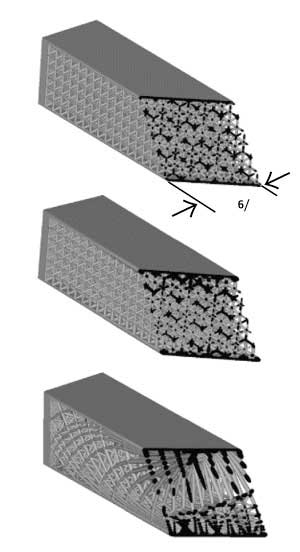| Posted: Mar 09, 2018 |
Nature inspires light, robust lattice structures
(Nanowerk News) Advances in materials engineering have led to the development of lightweight structures that are both strong and stiff, which are transforming aerospace, automotive and medical industries. Conventional manufacturing techniques like casting and machining, however, limit the designs that can be fabricated as they are prone to inaccuracies and struggle to achieve the best results.
|
|
Now, scientists at A*STAR have invented a method that uses additive manufacturing techniques to create lightweight lattice structures with greatly improved stiffness and strength (Materials & Design, "Optimisation of functionally graded lattice structures using isostatic lines"), paving the way for new materials for use in a wide range of applications including impact absorbent materials and sandwich structures.
|
 |
| Lattice designs: (top) uniform benchmark, (middle) diameter graded and (bottom) spatially graded. (© Elsevier)
|
|
The design and optimization of lightweight cellular and lattice structures is an emerging field made possible by advances in metal and polymer additive manufacturing, such as the ability to accurately print highly complex geometries.
|
|
By mimicking structures occurring in nature, Stephen Daynes and colleagues from A*STAR’s Singapore Institute of Manufacturing Technology have developed a method to create these new robust materials in collaboration with researchers from the National University of Singapore.
|
|
“Lattice structures exceed the structural performance of conventional solid materials for use in lightweight sandwich cores, medical implants and a new class of lattice-type metamaterials with specific mechanical and thermal properties,” explains Daynes. “Using a new biomimetic method, we were able to create cellular and lattice structures similar to those seen in bamboo and human bones.”
|
|
The researchers determined the principal lines of stress, called isostatic lines, in the lattice using a method that combines topology and size optimization. This approach allows the size, shape and orientation of each cell in the structure to be tailored, significantly reducing the stress between neighboring lattice cells.
|
|
The researchers compared the performance of their graded lattice structure with a uniform lattice core and found that their optimized design had increased stiffness by 172 per cent and strength by 100 per cent.
|
|
“Our technique can create lightweight, functionally graded lattices that greatly improve the stiffness and strength of additively manufactured sandwich structures without increasing their mass,” says Daynes. “These structures are particularly well suited to additive manufacturing processes since they are largely unconstrained by manufacturing complexity.”
|
|
“We plan to apply the methodology to three dimensional stress fields, where employing spatially graded lattices can lead to novel and more weight efficient materials,” says Daynes.
|

